This was published 7 months ago
‘The Thunderer’: How The Age has shaped public opinion and held a mirror to society
An editorial does not exist to please. As The Age turns 170, we look back at editorials which have served as barometers of the times, but also went against the general view.
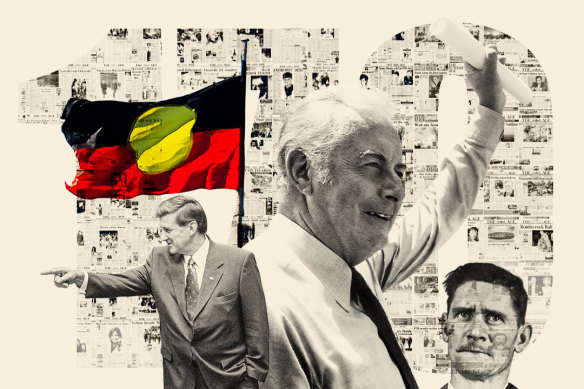
The Age editorials hold the powerful to account.Credit: Marija Ercegovac
In its first issue on October 17, 1854, The Age declared on its front page what it saw as its mission. It was, in effect, its first editorial.
“We enter upon our task with a deep sense of its importance and responsibility. The newspaper has become the great teacher of the age. It exercises an influence more immediate, more extensive, and more powerful than that of the pulpit or the school. It directs public opinion. It gives permanent record to present history.”
This was a golden time, literally, in the history of Victoria. The road to the goldfields around Bendigo carried the most traffic in Australia.
In 1854, the State Library, the Museum, Melbourne University, the Victorian Railways and the MCG all began life. Melbourne was exploding with possibilities. The Age saw itself as the gatekeeper to the times, holding the powerful and politicians to account. This is still the case.
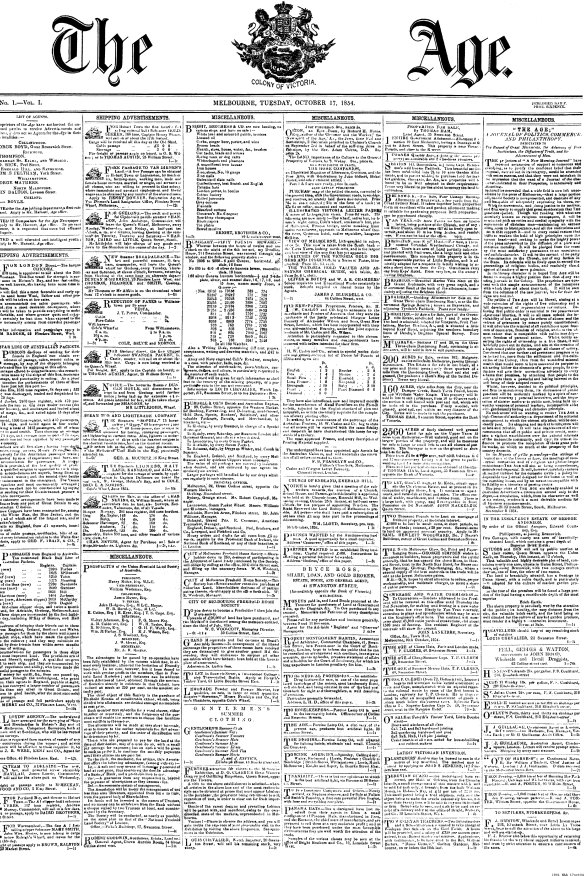
The Age’s first front page, published on October 17, 1854. The paper’s first editorial is at the top of the rightmost column.Credit: The Age archives
Though the fragmentation of the dissemination of opinion has exploded beyond what The Age of 170 years ago could possibly have imagined, the bedrock of its founding principles still holds true.
The editorials of The Age were such that the paper came to be known as “The Thunderer”. It didn’t hold back.
The editorial is a barometer of the times. Sometimes, being for or against a subject may be at odds with a general view. Its argument, however, must be in that case unbreakable.
A mirror to society
The editorial through the decades also reflects how society has changed. The paper’s editorials on two executions by the state, that of Ned Kelly, or as The Age called him, Edward Kelly, in 1880, and the last hanging in Australia, that of Ronald Ryan in 1967, highlight this.

Ned Kelly and Ronald Ryan.
On November 13, 1880, The Age wrote: “Now that Edward Kelly has paid the last penalty of the law, it may not be amiss to consider whether Melbourne has not witnessed sadder sights during the last few days than even the spectacle of a man deliberately put to death by his fellow creatures … Other men as ignorant and as weak as Kelly must learn from him that it is wise to refrain from bloodshed; that the state is stronger than any one citizen; and that no fictitious romance, no maudlin sympathy, no venal oratory, will avail against the inexorable common senses of the governing majority.”
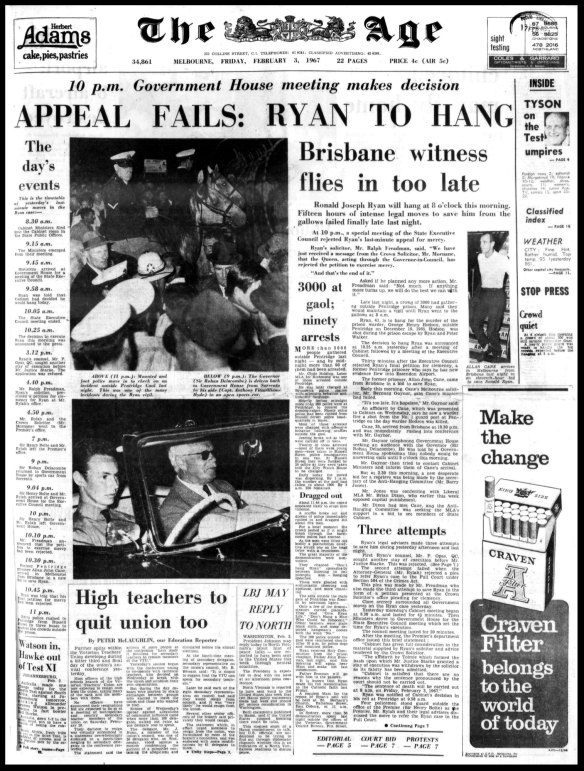
The Age front page published on February 3, 1967, before the hanging of Ronald Ryan.Credit: The Age archives
In 1967, it wrote of Ryan: “Why hang Ronald Ryan? Why make him the exception? Sir Henry Bolte and his colleagues have refused to answer or even discuss these questions in public … Was Ryan’s crime far worse than any other recent murders? Demonstrably it was not. He is the 36th murderer to seek, during the term of the Bolte government, commutation of the death penalty. The other 35 succeeded where Ryan has so far failed. His crime, like all other murders, was foul, but there are degrees of foulness.”
Editorial writers must walk a fine line between hotheaded righteousness and simply and calmly saying what they believe to be right when circumstances change. This was put to the test from December 1972, and the federal election between then prime minister William McMahon and Labor leader Gough Whitlam that would convulse the political landscape and society.
Political turmoil, social changes
On December 1, The Age declared: “We believe Labor should be elected to govern Australia in tomorrow’s ballot. We do not argue with a sense of absolute conviction because neither the Labor Party nor the Liberal-National Party coalition has a monopoly of political virtue. Indeed, there is very little in the record of the McMahon government or the potential of a Whitlam government to justify total certainty.”
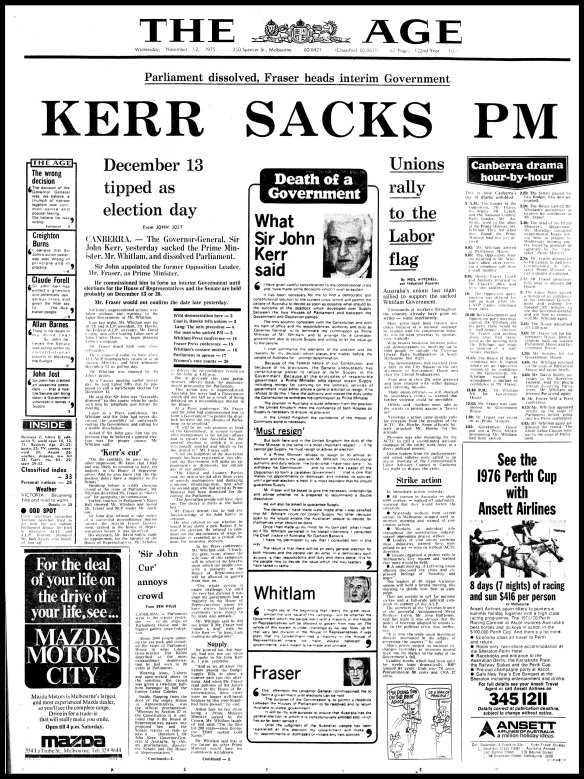
The Age’s front page reporting on the 1975 dismissal of Gough Whitlam.Credit: The Age archives
Three years later, victory had become a trainwreck. Whitlam had won control of the House of Representatives, but not the Senate. He called another election in 1974, which he won, but still needed to call a joint sitting of the two houses to get vital bills of parliament passed. In 1975, the opposition blocked supply. Whitlam and opposition leader Malcolm Fraser both went to then governor-general Sir John Kerr to find a way through the impasse.
On October 15, just a month from the 1975 double dissolution, The Age made its pronouncement: “We will say it straight, and clear, and at once. The Whitlam government has run its course; it must go now, and preferably by the honourable course of resignation – a course which would dispel all arguments about constitutional proprieties, historic conventions and ‘grabs’ for power. It must go because it no longer has the degree of public support and acceptance that permits governments to govern effectively.”
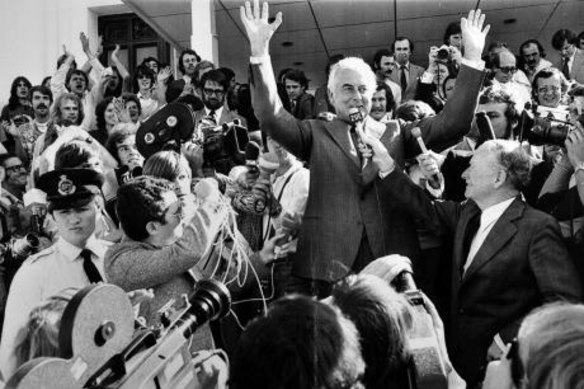
Former prime minister Gough Whitlam on the steps of Parliament House after his dismissal in 1975.Credit: The Age archives
However, when the Whitlam government was extraordinarily sacked by Kerr on November 11, it spoke out the next day: “Yesterday was the most extraordinary in the political life of this nation. It was also one of the most regrettable. The decision of the Governor-General, Sir John Kerr, to dismiss the Whitlam Government was, we believe, a triumph of narrow legalism over common sense and popular feeling. We do not deny that Sir John had been placed in an appallingly difficult position by two stubborn men … But we believe he was wrong … Mr Fraser bears a heavy responsibility for this. But Mr Whitlam is far from blameless. If his Government had been more competent and circumspect, the Opposition might have been less tempted. Both of them at least owe the public a decent and responsible election campaign.”
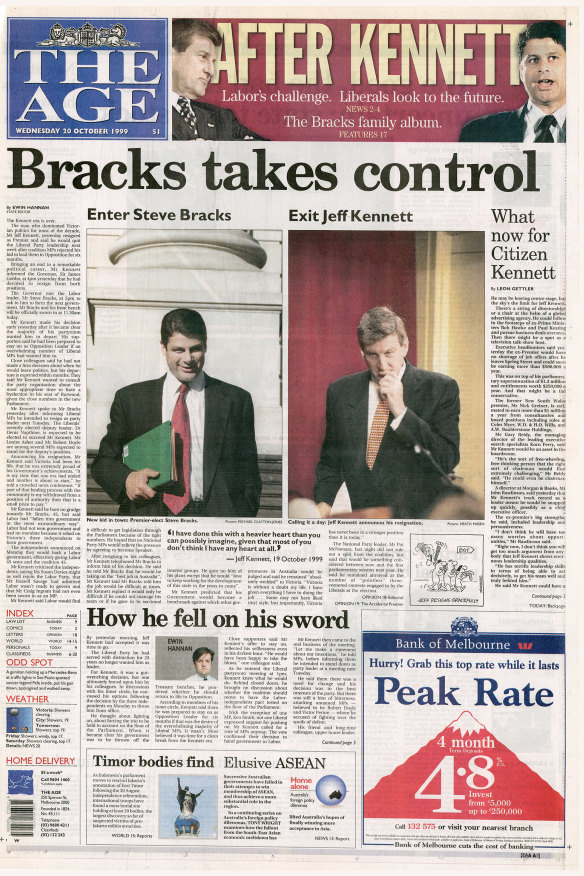
The Age front page from October 20, 1999, shows the changing of the guard in Spring Street.Credit: The Age archives
In Victoria, the greatest watershed of recent decades was the loss of the Kennett government in 1999. Jeff Kennett, after years in and out of favour with his party, the Liberals, presided over a landslide victory over Labor in 1992. Though he retained power in 1996, a groundswell of opposition to his style of government was building. In 1999, it came to a head when Labor won back office with the help of three independents.
The Age declared on October 20: “Dignity sometimes seems to be an outworn notion in politics. But by announcing his resignation yesterday as Premier and Liberal leader, Mr Jeff Kennett chose an exit that maintains dignity not only for himself but for Victoria’s system of government.”
The Age has also been at the forefront on championing social justice causes. It celebrated the vote on marriage equality in 2017. However, it was less than happy at the manner in which it was achieved.
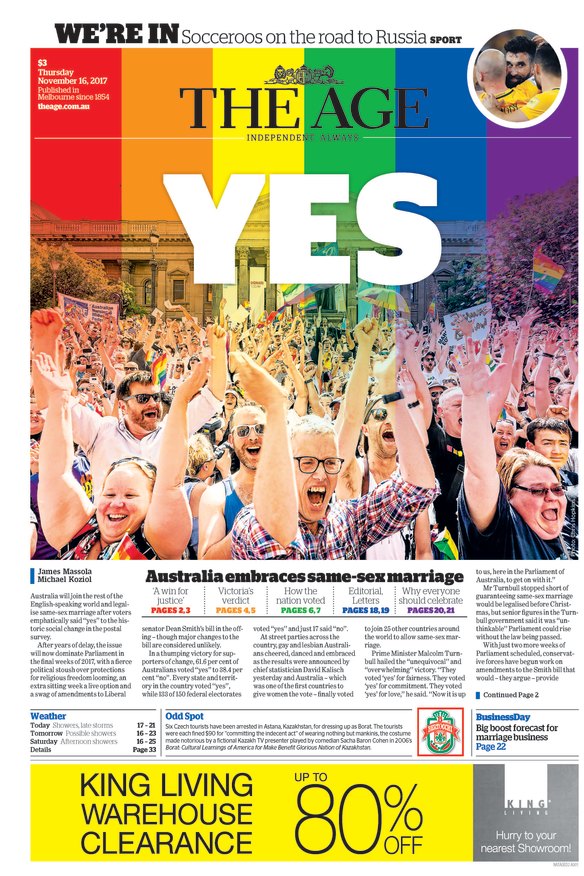
The Age’s front page on November 16, 2017.Credit: The Age archives
“The resounding endorsement by Australians of marriage equality is to be celebrated. The process is to be lamented. And the ongoing attempt by a recalcitrant sector of the Coalition to stymie the change is to be decried. Parliament now has no choice but to do the work it should have done sooner, instead of cynically foisting the unnecessary non-binding national survey on the nation ... Marriage equality, supported by an unambiguous majority in every state and territory, has long been inevitable because it removes an archaic, unconscionable injustice. There is no rational justification to deny people in love the right to marry. Opposition to marriage equality is rooted in discrimination.”
It could also tug the forelock, while offering a distinct rider, as in an editorial in 2015, congratulating the late Queen Elizabeth II on becoming the longest-serving monarch in English history.
“We congratulate the Queen, and applaud her life of unwavering service to millions of people of many nations. For it is not merely the Queen’s length of service that impresses, it is her manner of service. She is an emblem of constancy, of dedication to duty ... The Age believes Australia should and will become a republic. We believe it is something the Queen would not oppose, if it were the wish of the people. For now, though, we offer best wishes to a formidable monarch.”
Never could tone be more stark than in this editorial from 2023, in which The Age laments an opportunity lost with the rejection of the Voice referendum question:
“How does the nation move forward from here? Australian voters have categorically rejected the Voice referendum after a rancorous and, at times, toxic debate that has left unresolved the profound questions about how to manage policies affecting Indigenous people ... The Age strongly supported the Voice. We also believe that holding the referendum was the right thing to do. It was a proposal worth taking to the people, and now was the time to take it.”
An editorial does not exist to please. It exists because an issue demands a view. This is its call and response. This is The Age.
Start the day with a summary of the day’s most important and interesting stories, analysis and insights. Sign up for our Morning Edition newsletter.